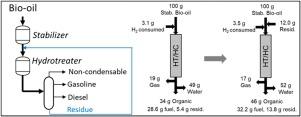Catalysis Today ( IF 5.2 ) Pub Date : 2020-10-16 , DOI: 10.1016/j.cattod.2020.08.035 Huamin Wang , Pimphan A. Meyer , Daniel M. Santosa , Cheng Zhu , Mariefel V. Olarte , Susanne B. Jones , Alan H. Zacher

|
Fast pyrolysis of biomass followed by hydrotreating can contribute to renewable fuel by producing hydrocarbon fuel blendstocks. Upgrading bio-oil via hydrotreating technology can be both capital and operating cost intensive. This study provides an approach to improve the process economics by eliminating the separate hydrocracking step that converts the heavier-than-diesel fraction (residue with boiling point >338 °C) and recycling the residue and co-processing it with stabilized bio-oil in the hydrotreating reactor. We report here the performance of co-processing a pine bio-oil residue with stabilized oak and pine bio-oil in a continuous flow hydrotreater. With the residue co-processing ratios (6/100 to 13.5/100 g/g residue to bio-oil ratio) used in this research, 30–50% of the residue was converted to lighter products (diesel, jet, and gasoline range products) with no effect on bio-oil conversion. This suggests that parallel hydrotreating and hydrocracking reactions were occurring in the hydrotreater during co-processing with potential synergy between the two components. The study determined economic impact of the improved process, in which the separate hydrocracker was eliminated, and the residue fraction that was recycled to the hydrotreating reactor. The results showed a 6% reduction in the conversion cost. Approximately 57% of the cost reduction was due to elimination of capital equipment and 43% was due to lowering operating costs, including decreases in chemical consumption, utilities, and labor.
中文翻译:

生物油加氢共处理残余重质馏分的性能和技术经济评价
生物质的快速热解,然后进行加氢处理,可以通过生产烃类燃料调合原料来产生可再生燃料。通过加氢处理技术升级生物油可能需要大量资金和运营成本。这项研究提供了一种方法,可通过消除单独的加氢裂化步骤来提高工艺经济性,该加氢裂化步骤可将重于柴油的馏分(沸点> 338°C的残渣)转化为残渣,并将其循环再利用稳定的生物油进行共处理。加氢处理反应器。我们在这里报告了在连续流加氢处理机中与稳定的橡木和松木生物油共同处理松木生物油残渣的性能。通过本研究中使用的残渣协同处理比率(残渣与生物油的比率为6/100至13.5 / 100 g / g),将30–50%的残渣转化为较轻的产品(柴油,喷气机,和汽油系列产品)对生物油转化率没有影响。这表明在共处理过程中加氢处理机中发生了平行加氢处理和加氢裂化反应,两种成分之间可能具有协同作用。该研究确定了改进工艺的经济影响,该工艺消除了单独的加氢裂化器,并将残余物馏分再循环至加氢处理反应器。结果表明转换成本降低了6%。大约57%的成本降低是由于消除了资本设备,而43%的成本是由于降低了运营成本,包括减少了化学药品的消耗,公用事业和劳动力。这表明在共处理过程中加氢处理机中发生了平行加氢处理和加氢裂化反应,两种成分之间可能具有协同作用。该研究确定了改进工艺的经济影响,该工艺消除了单独的加氢裂化器,并将残余物馏分再循环至加氢处理反应器。结果表明转换成本降低了6%。大约57%的成本降低是由于消除了资本设备,而43%的成本是由于降低了运营成本,包括减少了化学药品的消耗,公用事业和劳动力。这表明在共处理过程中加氢处理机中发生了平行加氢处理和加氢裂化反应,两种成分之间可能具有协同作用。该研究确定了改进工艺的经济影响,该工艺消除了单独的加氢裂化器,并将残余物馏分再循环至加氢处理反应器。结果表明转换成本降低了6%。大约57%的成本降低是由于消除了资本设备,而43%的成本是由于降低了运营成本,包括减少了化学药品的消耗,公用事业和劳动力。结果表明转换成本降低了6%。大约57%的成本降低是由于消除了资本设备,而43%的成本是由于降低了运营成本,包括减少了化学药品的消耗,公用事业和劳动力。结果表明转换成本降低了6%。大约57%的成本降低是由于消除了资本设备,而43%的成本是由于降低了运营成本,包括减少了化学药品的消耗,公用事业和劳动力。











































 京公网安备 11010802027423号
京公网安备 11010802027423号